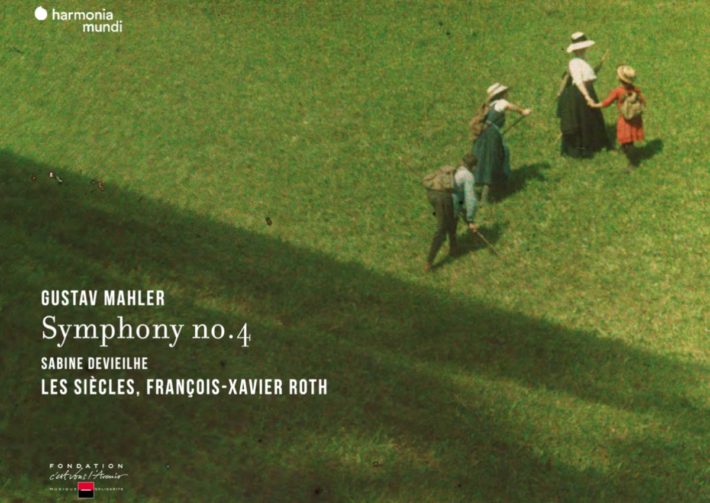Roth’s exploration of the Mahler symphonies has utilized both modern and period instruments. Symphonies 3 and 5 were with the Gürzenich-Orchester Köln (Harmonia Mundi), and Symphony No. 1 with the Sinfonieorchestre Baden-Baden und Freiburg (Hänssler). More recently, he released a fascinating and authoritative performance the 1893 version of the first symphony (“Titan”), played by Les Siècles.
In those readings Roth’s priorities are technical precision, transparent orchestral textures, and flowing tempos. He never dawdles and presents an objective, less overtly theatrical approach than Bernstein or Tennstedt. The Les Siècles recording is, for me, the most successful, the period instruments offering a more heterogenous color palette, with interesting differences in approach to articulation and balance that enable us to hear the differences in the 1893 and final versions.
This latest release is engaging for similar reasons: the orchestral sound has a plain-spoken honesty, less sophisticated than what modern instruments offer perhaps, but offering a different prism through which to appreciate Mahler’s orchestration. Woodwinds are more pungent, horns, forward in aural mix, more brazen. Strings are agile, but light, lacking heft – at times, their sound is insubstantial compared to orchestras in Amsterdam, Berlin and Vienna, or the recent performance by the Czech Philharmonic under Bychkov (Pentatone).
Roth has a clear sense of each movement’s architecture, and his use of rubato is understated. The gear changes in the opening movement are smoothly managed, though I am not convinced that is Mahler’s intent. Turn to Rattle (Warner Classics) or Adam Fischer (Avi Music) and the results are far more frenetic. While some may argue their performances are overwrought, if one listens to Mahler’s piano-roll recordings, his rubato is anything but subtle.
Related
- Review: Mahler – Symphony No. 4 – Minnesota Orchestra, Vänskä
- Review: Mahler – Symphony No. 4 – LPO, Jurowski
- Review: Mahler – Symphony No. 7 – Bayerisches Staatsorchester, Kirill Petrenko
The first two movements, however, consistently engage because of the riotous amount of color Roth and his players draw from the score. The second movement playfully sparkles, the scordatura violin played with panache, though its rude sarcasm strikes me as too polite.
The third movement raises more substantial concerns. Taking less than 21 minutes, this is the faster performance I know, and although it never feels rushed, it does skirt the emotional surface. There it not enough difference in sound and mood between the two themes, and the lack of substance and minimal use of string vibrato frustrates. Surely Mahler would have encouraged numerous approaches to string playing?
Roth’s emotional reticence is readily apparent at the build up to third movement’s first desperate climax, where Roth pushes through instead of stretching the line: the moment is merely loud, and emotionally cold. Kept from adopting a variety of vibrato, the strings do use glissandos. Is this authentic? We know Mengelberg employed this technique and that Mahler thought highly of his colleague’s interpretations. But in playing that fails to create an emotional connection, the glissandos sound oddly forced. The arrival at the gates to heaven lacks the sheer heft and splendor needed, and while the final bars have a touching fragility, the emotional impact is lessened because this is the color and affect we have heard for most of the movement.
The fourth movement, again rather quick, is nevertheless nicely shaped and Sabine Devieilhe’s singing is charming and childlike, without eclipsing the performances by Barbara Hendricks (Salonen/Sony), Barbara Bonney (Chailly/Decca) and Camilla Tilling (Zander/Telarc).
The liner notes include an interesting interview with Roth, as well as erudite notes by Anna Stoll Knecht and Benjamin Garzia. Recorded sound is fine, though the winds have more presence in the overall sound than we would experience in a typical concert hall.
This is an interesting recording that impresses with its energy and freshness but lacks the emotional acuity and power of more notable performances. Both Fischer brothers, in Düsseldorf and Budapest, lead readings similar to Roth’s interpretative ideas that feature far more emotional engagement. Ivan (Channel Classics) has the better orchestra, but Adam leads the more moving performance.

Mahler – Symphony No. 4
Les Siècles
François-Xavier Roth – Conductor
Harmonia Mundi, CD 905357
Recommended Comparisons
Read more classical music reviews or visit The Classic Review Amazon store
Follow Us and Comment:
Get our periodic classical music newsletter with our recent reviews, news and beginners guides.
We respect your privacy.









